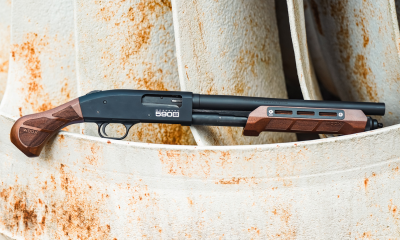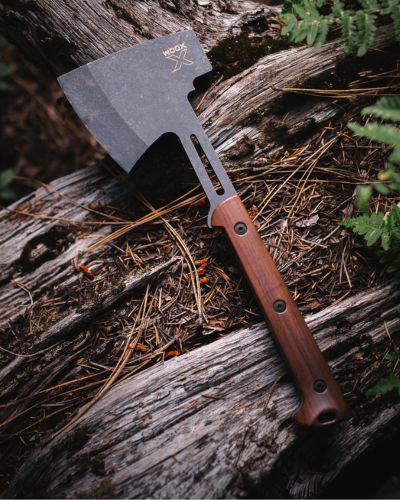Christmas delivery is no longer guaranteed.

Christmas delivery is no longer guaranteed.
GUN PARTS
AXES
KNIVES

Home, Sweet Home- How To Pick The Perfect Campsite
February 08, 2021 4 min read 1 Comment
Fresh air. Beautiful vistas. The wind gently sighing through the trees and caressing your face as you feel the warm glow of the sun soak through your skin. These are some of the reasons we head out to the woods and stay for a while, enjoying what nature can give us. But if we make a mistake, our idyllic communion with the wild can turn into a complete disaster. And it all starts with where you pitch your tent, so let’s talk about these tips to help you pick the perfect campsite.
The very first thing you must consider when you are looking for a spot to set up camp is WHEN you should start looking. You should start your search at least two hours before sunset to give yourself ample time to find a place that will meet your needs and minimize your effect on the environment.

Assuming you’re using a tent, you want to find a piece of level ground that is free of large rocks, bushes, roots sticking up, and other obstacles. Try to find a space that is large enough for your party, and if possible, find an established site. This lessens the chance of you damaging an otherwise untouched habitat. If no established site is available, try to find a place where you will cause the least disturbance.
There are more things to consider, however. Your campsite should be close to water for drinking, cooking, and bathing. Be mindful that “close to water” does not mean “on the water”. Look for a place 200 feet or so away from the water’s edge. This helps keep you from inadvertently contaminating the water source. It also keeps you away from any insects that may live in the water and allows wildlife to access the water if they need to.
There’s another reason that you should avoid camping right on the water. Water is usually found on the lowest ground around. That means if it rains upstream, you’re likely to wake to find your tent trying to pull double duty as a raft… and probably not very well. Also, cold air tends to follow the same path as water and collects in the same places.
Therefore, your campsite should be located on higher ground. But avoid the temptation to climb the nearest hill and set up housekeeping. You’ll have farther to go for your water. You’ll be exposed to the wind, and if you’re the tallest thing around you just might attract lightning.
I like to find a place ½ to ¾ of the way up a hillside, with either a spring running down the hill or a creek or other water source at the bottom. This lets me be out of the cold air, away from the bugs and protected from the wind. As a bonus, I'm unlikely to wake up to a flooded camp.
Do you plan to have a fire? You need to look for a place with enough deadwood to last you for your anticipated length of stay. Look for fallen trees that are dead and not sitting entirely on the ground. Dead trees that are on the ground tend to soak up moisture. You want to find some that have a good portion of their limbs nice and high… and consequently, dry.
One word of caution about dead standing trees- make absolutely CERTAIN that none can fall anywhere near your camp. Also, make sure that any live trees nearby don’t have dead limbs that overhang your camp. Dead standing trees and overhanging dead limbs are called “widow makers” for a reason. If they fall on your tent during that hypothetical storm in the night, they can easily kill you. It’s best to avoid a spot that has that danger, even if it’s otherwise perfect.
If you’re in bear country, you need to find a place away from your camp to hang your food. You want to find a limb around 25 feet in the air, at least 7 feet from the tree. It should be downwind, at least 100 yards away. Bears have sensitive noses and will follow a scent from a long way off to find food… and you don’t want one to follow that scent through your camp.

For the same reason, you want to find a place downwind from your sleeping area to do your cooking. This spot should be 100 yards from your tent and 100 yards away from your food storage. Think of it as a triangle, with your tent, food bag, and kitchen as the points, and the tent pointing into the wind.
You might want to think about keeping out of open fields. If you stay 20 yards back in the trees you will gain protection from the wind. Not to mention some much-appreciated shade.
Another thing to consider is sun exposure. This is yet another reason you shouldn’t set up in the bottom of a valley or hollow. By being halfway to ¾ of the way up the slope, you get the benefit of longer periods of sunlight during the day. This is especially true if you have a place on a southern facing slope.
You should also avoid setting up on game trails. For one thing, you’ll disturb the wildlife. For another, there’s a good chance the wildlife will disturb you. And if it’s Mr. Bear who rounds a bend and walks into the middle of your camp things could get a little bit exciting!
Camping can be a wonderful, even magical, experience. It can lift your spirits and soothe your soul… or it can be the cause of misery. It all starts with how you approach your decision making in the woods, and one of the most important decisions you’ll make is where you’re going to set up your home, sweet home. Follow the advice in this post and you’ll be a lot more likely to come away with treasured memories.
How do you usually pick your perfect campsite? Feel free to share your tips in the comments below!
1 Response
Leave a comment
Comments will be approved before showing up.
Also in Woox Journal

PTR 9CT: Stock, Grip & Rail Upgrades - WOOX 1913 WOODY
December 12, 2025 1 min read
WOOX’s handcrafted American walnut stock, M‑LOK vertical grip and rail panels turn any rifle into a blend of classic craftsmanship and modern modular performance — perfect for hunters and shooters who value both heritage and function.

PSAK-47 GF3 & WOOX Forty Seven: Power Meets Heritage
December 12, 2025 1 min read
The WOOX Forty Seven combines timeless craftsmanship and thoughtful design, creating an immersive, adventure-ready experience for those who seek the wilderness.

The Mossberg Maverick 88: A Working-Man’s Shotgun Raised to a Higher Calling
December 09, 2025 1 min read
The Mossberg Maverick 88 evolves from rugged workhorse to heirloom-quality shotgun with Gladiatore walnut and aluminum furniture—performance and craftsmanship combined.
STICK AROUND AND STAY UPDATED!
Want the latest promotions, expert tips, and a cool sticker set?
Subscribe to our newsletter today.
Spam? Not on our watch!

















Fabio Cortinovis
February 09, 2021
Very informative, I’m new to camping and I found lots of useful insights in this article.
Thanks!